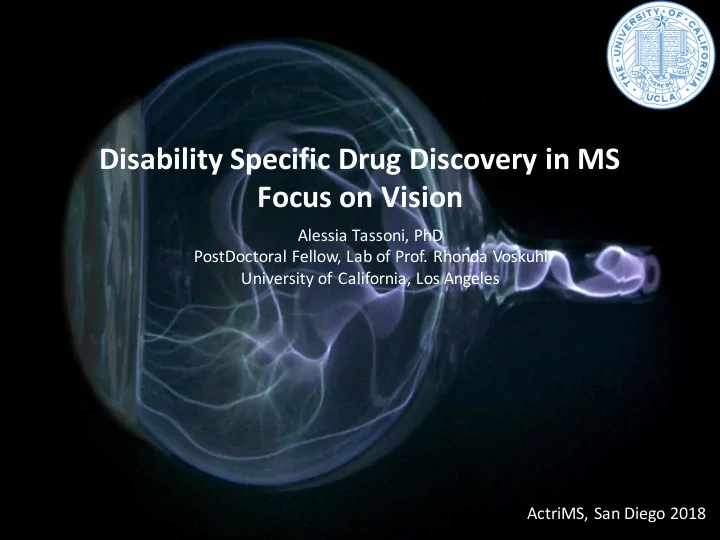

Disability Specific Drug Discovery in MS Focus on Vision Alessia Tassoni, PhD PostDoctoral Fellow, Lab of Prof. Rhonda Voskuhl University of California, Los Angeles ActriMS, San Diego 2018
Optic neuritis in MS Frequent disability in MS • Inflammatory demyelination of the optic • nerve Visual loss • • Biomarker: OCT RNFL thinning indicates axonal loss Pathology: • Inflammation/ON Demyelination/ON RGC axonal loss/ON RGC body death/retina Neuroprotective therapies needed Mission: Discover neuroprotective treatments optimally tailored for visual disability in MS
Optic neuritis in EAE: Neuroinflammationand demyelination MOG 35-55 chronic EAE Optic nerve Retina Control 21dpi 50dpi 8dpi CD45/PLP 8 dpi 21 dpi 50 dpi 8 dpi 21 dpi 50 dpi Iba1/MHCII 8 dpi 21 dpi 50 dpi 8 dpi 21 dpi 50 dpi GFAP/LCN2 8 dpi 21 dpi 50 dpi 8 dpi 21 dpi 50 dpi
Optic neuritis in EAE: Neurodegeneration RNFL thinning by OCT RGC death and axonalloss by pathology Control 21dpi 50dpi 8dpi Optic nerve 8 dpi 21 dpi 50 dpi Retina 8 dpi 21 dpi 50 dpi
Which molecule from which cell is driving visual disability progression? Ribo Tag Technology .Sanz E, et al PNAS 2009 Discriminate gene expression changes within specific cell types in EAE optic nerve
GFAP Cre (73.12) Ribo Tag optic nerve Astrocytes: Key Regulators of Neuroinflammation (timing, injury, severity) Beneficial (Voskuhl RR, J Neuorsci 2009, Anderson MA, Burda JE et al, Nature 2016) Detrimental (Brambilla R, J Neuroinflam. 2012, Mayo L, Nat Med 2014, Liddelow S, Nature 2017) HA/GFAP Colocalization Cell specific enrichment & de-enrichment Gfap (Astrocytes) Ptprc (Microglia) Mbp (Oligo) Gap43 (Axons) -4 0 2 4 -6 -2 Log2 FC (HA-IP/FT)
RNA seq pathway analysis in optic nerve astrocytes EAE optic nerve astrocytes GFAP Cre RiboTag MOG 35-55 chronic EAE Cell-specific and region-specific transcriptomics in the multiple sclerosis model: Focus on astrocytes. Itoh N, Itoh Y, Tassoni A PNAS , 2017 EAE Spinal cord astrocytes See Poster # 195 Region-specific differences in astrocytes during EAE N. Itoh, Prof. Voskuhl
Optic nerve astrocytes display an A1 phenotype: RNA Seq Activation of complement during disease can be detrimental to neurons (Stephan AH, Annu Rev Neurosci. 2012) • Astrocyte defined as detrimental (A1) or beneficial (A2) ( Zamanianet al. J Neurosci 2012 ) • Complement component 3 regarded as important upregulated A1 gene ( Liddelow SA et al, Nature 2017 ) • Merge C3 GFAP Control EAE Our data in the MS model are consistent with an important role of A1 astrocytes in the optic nerve crush injury model (Liddelow SA, Nature 2017)
Conclusions: RNA seq data performed on astrocyte mRNA obtained from different regions • across the CNS revealed regional differences in astrocyte specific gene expression during EAE. (PNAS 12/26/17 Epub, Jan 2018 issue. Poster #195) In multifocal disorders such as MS, molecular mechanisms underlying each disability • may differ based on the neurological pathway involved and, therefore, neuroprotective treatments tailored for each specific disability may be required. Molecular mechanisms of optic nerve disability progression in late EAE include • up-regulation of the complement cascade with acquisition of an A1-like phenotype. • Similar to spinal cord, optic nerve astrocytes also showed a decrease in cholesterol synthesis gene expression in late EAE. In summary, our cell-specific RiboTag approach in EAE can offer therapeutically • relevant insights into molecular mechanisms underlying visual disability in MS.
Acknowledgments: Rhonda Voskuhl Noriko Itoh Yuichiro Itoh Roy Kim Lisa Golden Vista Farkhondeh Kevin Herrera Michael Sofroniew Timothy O’Shea Funding: Thank you for the attention!
RNA seq pathway analysis in optic nerve astrocytes EAE optic nerve astrocytes GFAP Cre RiboTag MOG 35-55 chronic EAE Cell-specific and region-specific transcriptomics in the multiple sclerosis model: Focus on astrocytes. Itoh N, Itoh Y, Tassoni A PNAS , 2017 EAE Spinal cord astrocytes Spinal cord Optic nerve atea fraction % MHCII/GFAP 21 Ctrl 21 Ctrl 50 50 See Poster # 195 Region-specific differences in astrocytes during EAE N. Itoh, Prof. Voskuhl
Recommend
More recommend